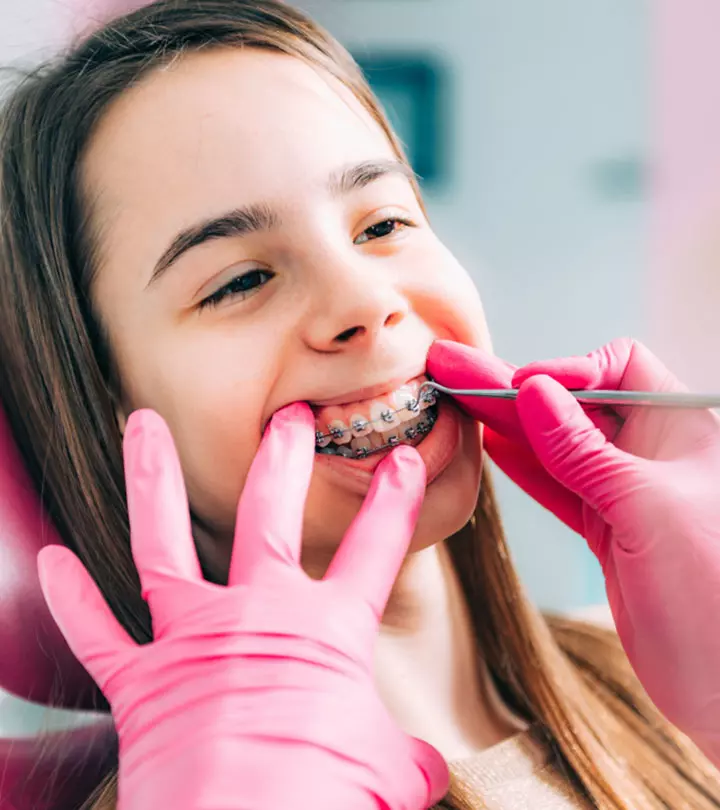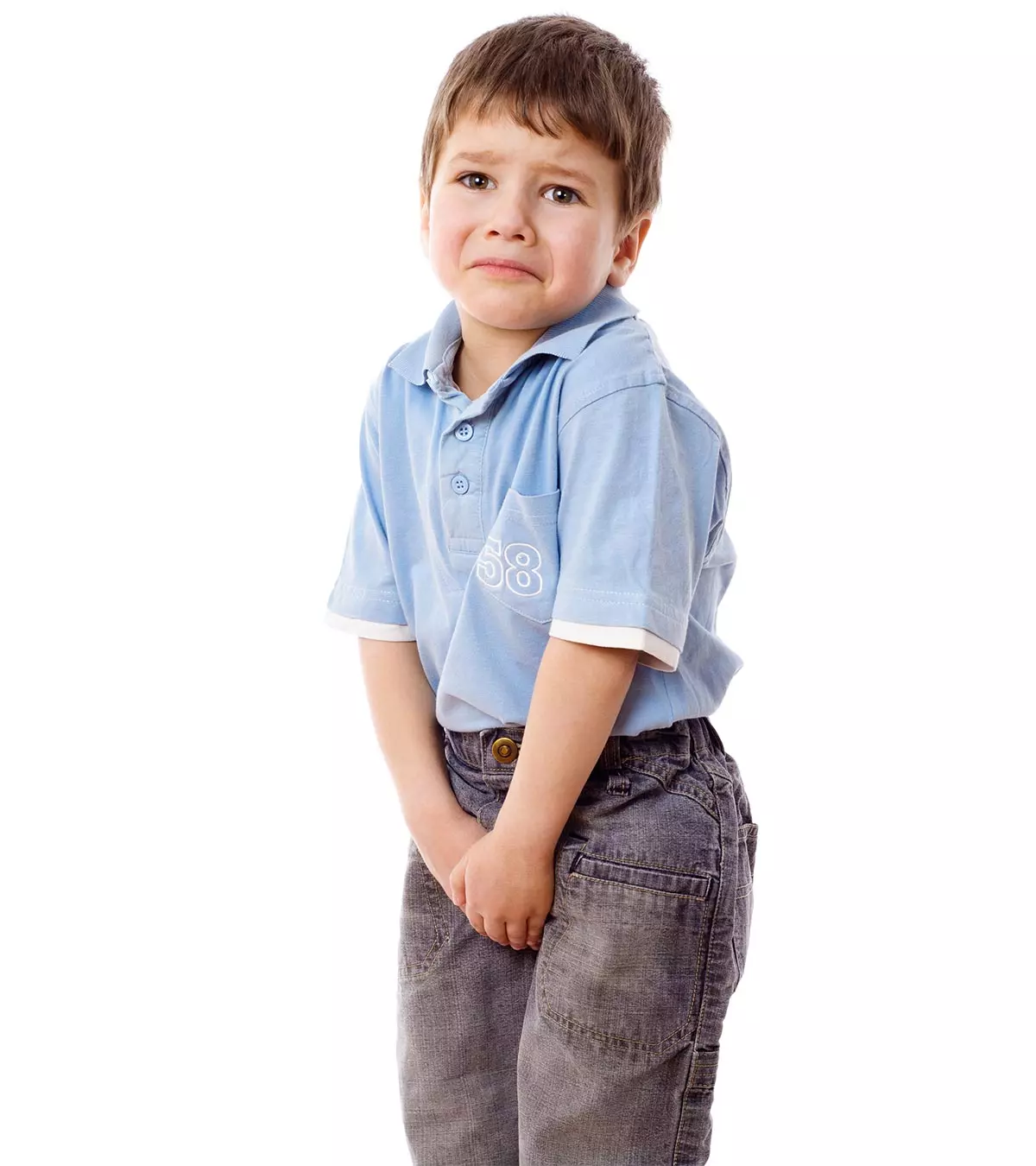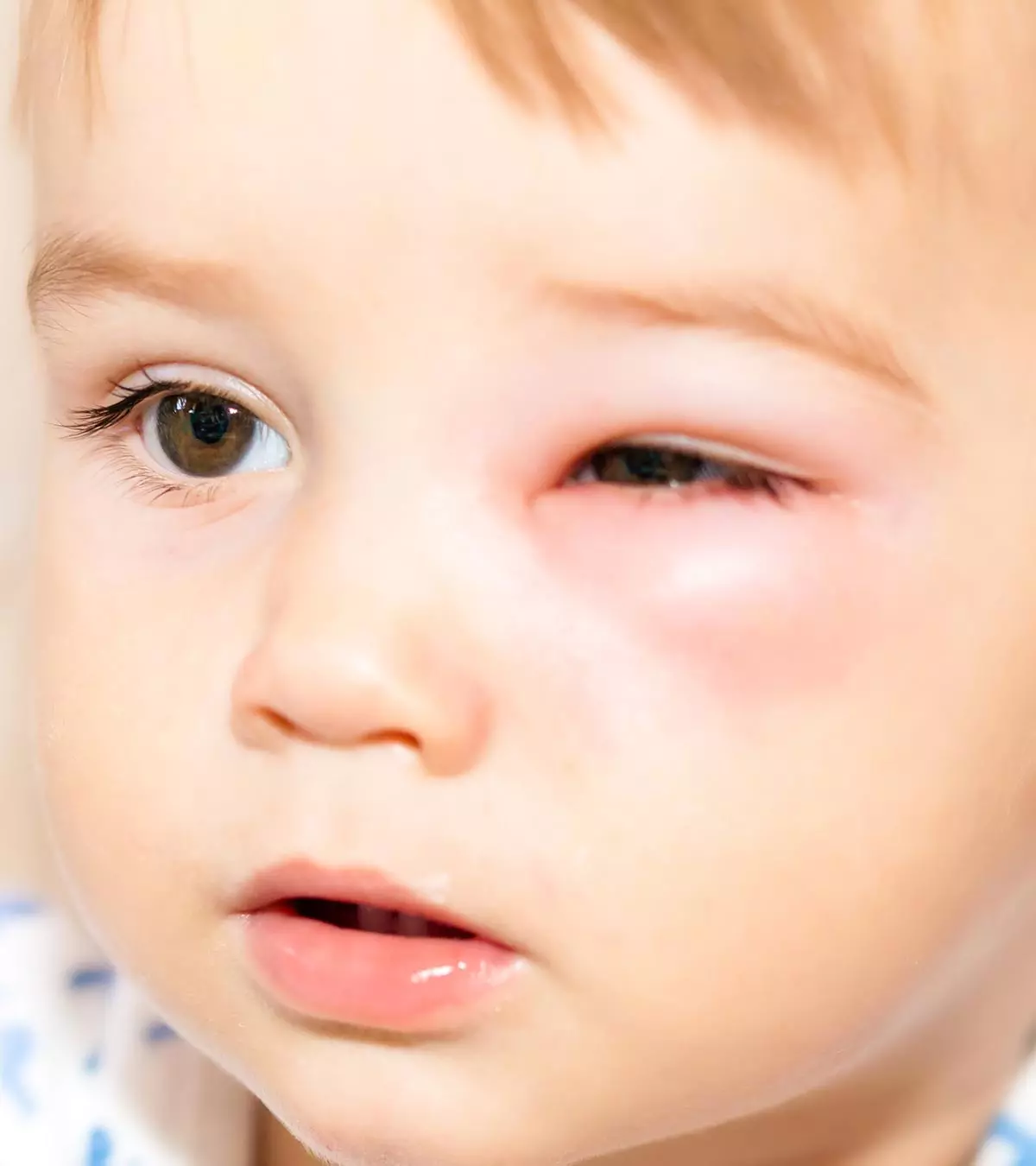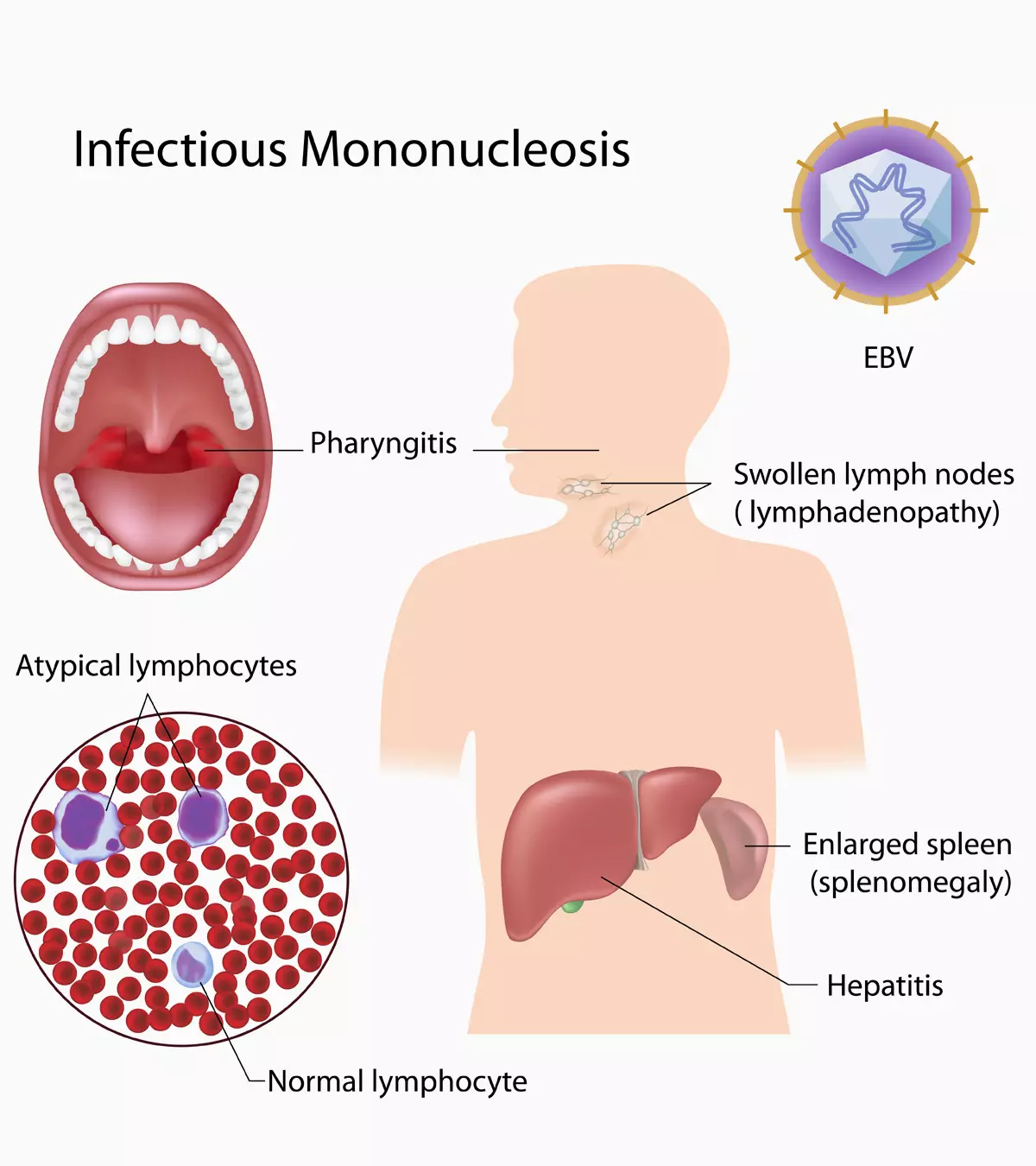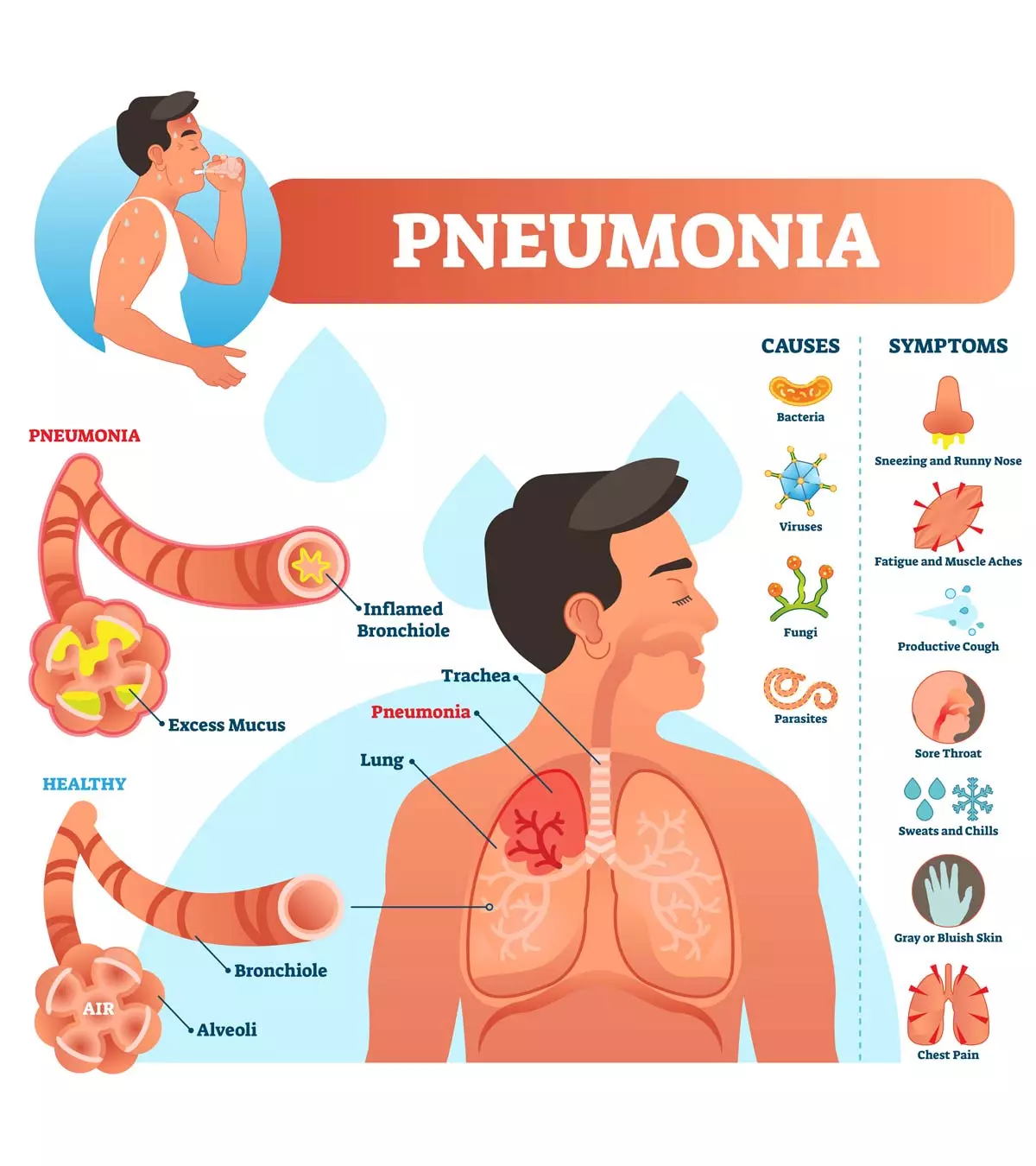
Image: Midjourney/ MomJunction Design Team
Any swelling or inflammation to the areas surrounding the eye may lead to swollen eyelids in children.Infections, allergies, insect bites, and injuries are the common causes of swelling in the eyes or eyelids of your child (1).

Some conditions lead to swelling in one eye, while others may cause swelling in both eyes. It is important to identify the signs and underlying causes for swollen or puffy eyelids in children to seek early treatments and avoid complications and future risks.
This post describes the signs and symptoms, possible causes, treatment, and management options for swollen eyes and eyelids in children. Knowing about these aspects can help you take necessary precautions and actions for your child when needed.
Key Pointers
- Swollen eyelids in children can occur for several reasons: an eye infection, injury, or allergic reaction.
- A child can have swelling in one or both eyelids and have associated symptoms, such as tenderness, redness, and watering.
- Mild eye swelling can improve by simple home care tips like abstaining from rubbing the eye/s or applying cold compresses on the swollen eyelid.
- Seek immediate medical care if the swelling looks severe or has worrisome additional symptoms like yellow or green pus discharge from the eye/s.
Symptoms Associated With Swollen Eyes In Children
The following symptoms are often associated with swollen eyes in children (2) (3).
- Pain
- Redness
- Tenderness
- Watery eyes
- Green or yellow pus discharge
- Dry eyes
- Itching
- Sensitive to light
- Blurred vision
Depending on the cause of swelling, associated symptoms may vary. Some conditions can be painful, whereas others may not cause pain despite causing swollen eyes.
 Quick fact
Quick factDepending on the severity, an eye swelling scale is established.
This includes (4):
- Mild swelling when the eyelid is puffy, but the child can open eyes normally.
- Moderate swelling when the eye is puffier, and there is some limitation in opening the eyes.
- Severe swelling when eyelid swelling closes the eyes, and children cannot open them.
Some eye conditions may also cause symptoms such as headache and fever.
You may seek medical care to identify the underlying reasons for these signs and symptoms.
Infographic: How To Differentiate The Causes Of Eyelid Swelling In Children?
Some thing wrong with infographic shortcode. please verify shortcode syntaxWhen To See A Doctor
Some conditions are self-limiting, while others may require medical care. You may seek immediate care if your child has (4):
- Swelling with redness of the eye
- Yellow or green pus discharge from the eyes
- Swelling due to eye injury
- Cuts or lacerations of the eye
- Bleeding from the eye
- Swelling of other parts of the body
- Swelling not improving with current treatments
It is usually good to see a doctor for any severe eye swelling and other symptoms since the eyes are delicate organs. Medical care can help in the exact diagnosis and treatment of the underlying condition.
Common Causes Of Eye Swelling In Children
Children can have eye swelling in one or both eyes. You may look for the other existing symptoms and signs to identify the condition. However, seek medical care if you face difficulty differentiating mild and severe causes to begin early treatment.
The following conditions may cause one-sided eye swelling (swelling in one eye) in children (4) (5) (6):
1. Rubbing the eye
Most children tend to rub their eyes if they have eye irritation. This may often cause swelling of the eyelids. Rough rubbing of the eyelids with dirty hands could increase eye irritation and cause swollen baby eyes. The important thing here is the initial cause of the eye irritation that led to the rubbing. Often it is allergies.
 Point to consider
Point to considerAccording to Yuna Rapoport, MD, MPH, a board-certified ophthalmologist in New York, “Most swollen eyelids are just allergies or water accumulation, but it can be a sign of a serious infection such as cellulitisiA bacterial skin infection that causes redness, swelling, warmth, and pain in the affected area. , or even a rare tumor like rhabdomyosarcomaiA rare cancer of soft tissue that affects muscles .”
2. Insect bite
An insect bite near the eye could cause swelling since the body reacts to it. Mosquito bites are quite common, and the eye may swell more than other body parts after a mosquito bite since the tissues are loose near the eye.
Bee or wasp sting near the eye can also cause swelling of the eye. You may notice more puffiness of the eye due to bee or wasp sting than a mosquito bite.
3. Contact dermatitis
Contact dermatitis occurs after the skin comes in contact with irritants or allergens such as poison ivy, certain soaps, baby products, etc. Allergens trigger skin inflammation that causes redness and swelling of the exposed area. If the skin near the eye is exposed to allergens, children may develop eye swelling. Another kind of dermatitis that causes swelling, redness, and itchiness around the eyes is atopic dermatitis, a common type of eczemaiA skin condition that causes inflammation, redness, itching, and dryness. .
4. Eye injury
Mild ocular trauma (eye injury), such as being struck by a moving object, can cause eye swelling. Children are vulnerable to eye injuries during sports and games. Mild eye injuries may cause a black eye due to bruising around the eye. More severe injuries can cause symptoms such as bleeding, uneven pupils, vomiting, stomach upset, and bruising may appear red (7).
If your child has a black eye, you may apply an ice pack immediately to reduce swelling. However, it is recommended to seek medical care to rule out other damage.
5. Stye
A stye, also known as a hordeolum, is a painful, red lump under the eyelid. A staphylococcal bacterial infection usually causes these small lumps (8). It may appear swollen and often causes itching. Stye in children may look like a pimple and is usually due to infection in the glands along the eyelid.

An external stye is due to the infection of glands of Zeis (oil gland) or Moll’s gland (sweat gland) present at the base of eyelashes. An internal stye is due to infection of the meibomian gland (oil gland), which is located in the eyelid. A stye may also appear if your child has blepharitis, which causes redness and swelling at the base of the eyelashes.
6. Chalazion
Enlargement of the meibomian gland in the eyelid is known as a chalazion. It appears as a swollen bump on the eyelid, and it may often begin as a stye. The eyelid can become swollen, red, and tender during chalazion, but it may not cause pain.
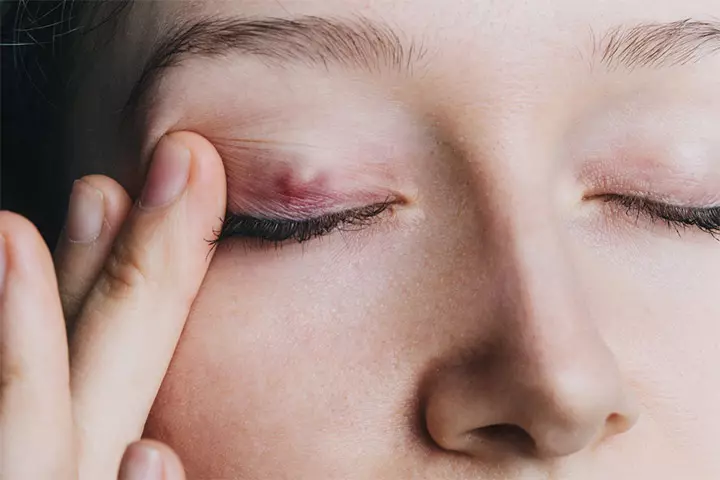
If the chalazion is too large, it may cause blurred vision due to compressions against the eye. Rarely, the entire eyelid may become swollen during a chalazion. Chalazion in children is painless swelling, whereas stye is painful and often develops along the rim or edge of the eyelid.
7. Dacryocystitis
Dacryocystitis is an inflammation of the lacrimal sac (tear sac) that usually happens due to the nasolacrimal duct (tear duct) blockage, which drains tears into the nose. It is located in the corner of the eye and appears swollen and red. Lumps are usually painful, and children may have a fever. An underdeveloped nasolacrimal duct at birth may cause a blocked tear duct in children. This duct might either be covered by a thin film or remain closed, resulting in partial blockage (9).
8. Ethmoid sinus infection
Ethmoid sinusitis may cause eyelid swelling and redness since it is located right behind the eye. Children may develop painful, puffy eyes during severe ethmoid sinus infections. Pain and tenderness between the eyes or on the nasal bridge are characteristic findings in ethmoid sinus issues.
9. Periorbital cellulitis
Periorbital cellulitis in children
involves the infection of the eyelid or the skin around the eyes. The infection usually spreads from an infected wound or insect bite site. The eyelid may become red and painful in this condition. A study of 175 pediatric cases of periorbital cellulitis over 10 years at a UK hospital found that symptoms like eye pain, proptosis (bulging eyes), and ophthalmoplegia (eye movement issues) are strong predictors of severe disease and need for surgery. Increased C-reactive protein levels also indicated higher risk. Early treatment and multidisciplinary care can improve outcomes, with surgery recommended for worsening cases to prevent serious complications (10).
10. Ocular herpes
Eye herpes or ocular herpes is a severe infection caused by the herpes simplex virus that usually affects one eye, although it could infect both eyes. Redness, pain, watery discharge, and light sensitivity are symptoms seen along with swelling (11).
Seek immediate medical care if your child has eye herpes since it often causes keratitis (corneal inflammation) and scarring that often requires a corneal transplant to avoid permanent vision damage.
The following conditions can cause eye swelling on both sides (swelling in both eyes) (4).
11. Allergic conjunctivitis
Allergic conjunctivitis is the inflammation of the conjunctivaiA membrane that covers the front part of the eye and also lines the inner surface of the eyelid caused by exposure to allergens. Common allergens include airborne allergens, such as pollen, dust, or certain fumes or chemicals. This may also cause redness and tearing, along with swelling. Such an allergic reaction is also common in the case of hay fever.
12. Viral conjunctivitis
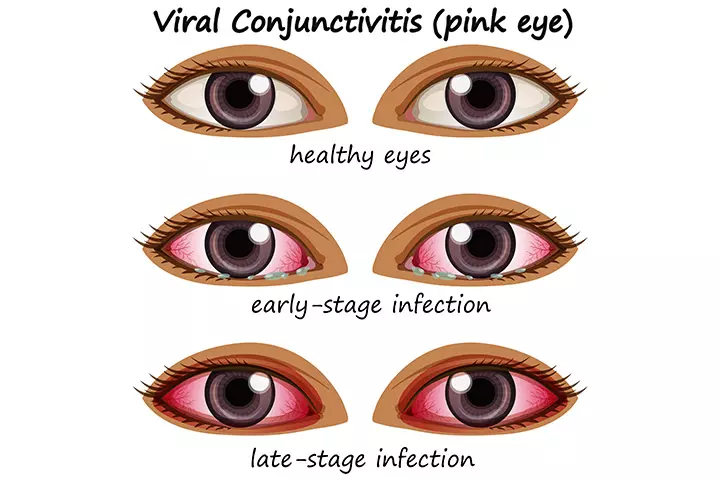
Viral conjunctivitis is the viral conjunctival infection, usually caused by adenovirus (12). This can cause swelling of the eyes on both sides. Watery discharge, light sensitivity, eyelids sticking together upon waking, blurred vision, and irritation are other common symptoms present with a viral infection (13). Children with colds may often develop viral conjunctivitis.
13. Bacterial conjunctivitis
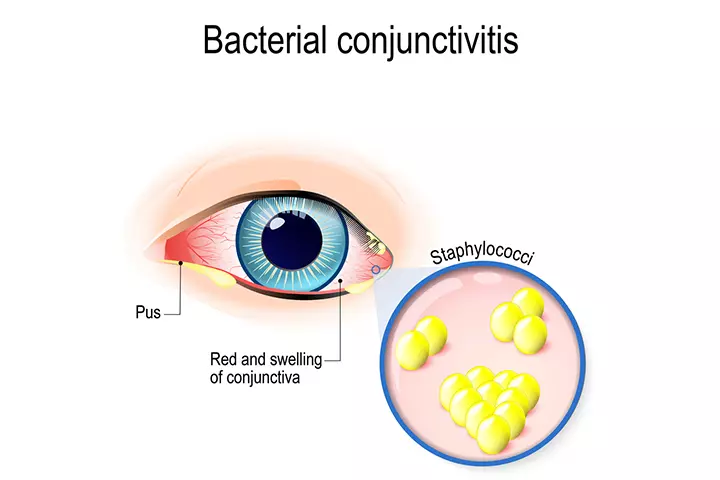
Bacterial conjunctivitis is the bacterial infection of the conjunctiva that may result in swelling of the eyes. Yellow discharge is common in this condition, and this may also cause eyelids to stick to each other. Sinus infections and ear infections often cause bacterial conjunctivitis in children. A study including 53 children found that most infections were caused by Staphylococcus aureus, with chloramphenicol being the most effective antibiotic (14).
A mother describes the symptoms and treatment her child received while dealing with pink eye (conjunctivitis). She says “My poor little monkey has pink eye… his eyes are getting red. He keeps telling me, ‘My eye hurts, my eye hurts.’ We just got home from the doctor’s appointment, and he has ear infections – a double ear infection, pink eye, and congestion. The doctor prescribed a new antibiotic eye drop and said to start using Motrin instead of Tylenol because it lasts a little longer and has the pain reliever (i).”
14. Edema around the eyes
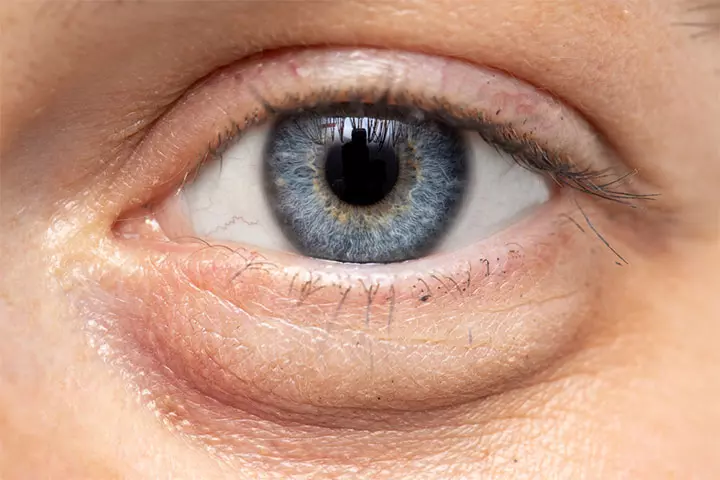
Systemic conditions that cause fluid retention in the body may lead to puffy eyes. Problems with the kidney, heart, and liver often cause swelling of the eyes. You may also notice swollen feet in such cases.
15. Anaphylaxis
Anaphylaxis or severe allergic reactions may often cause swelling of the eyes along with other symptoms. Breathing problems, swallowing difficulties, and hives (skin rashes) are often seen in allergic reactions. Certain foods, bee or wasp sting, and drugs are significant causes of anaphylaxis in children.
16. Grave’s ophthalmopathy
Grave’s ophthalmopathy or thyroid eye disease (TED) involves the orbit and periorbital tissues (15). This is an autoimmuneiA condition in which the body’s immune system attacks its healthy tissues inflammatory disorder usually affecting people with Grave’s diseaseiAn immune system disorder that causes the overproduction of thyroid hormones , and less frequently, people with Hashimoto’s thyroiditisiAn autoimmune condition that damages the thyroid gland and leads to an underproduction of thyroid hormone . Swelling of the eyes, eyelid retraction and lag, redness, and exophthalmos (bulging eyes) are usually seen in this condition.
17. Blepharitis
is a chronic condition causing inflammation of the eyelids. This is often due to conditions such as a stye, chalazion, etc. that clog oil-producing glands of the eyes. A child might have a higher chance of developing blepharitis if they have seborrheic dermatitisiA skin condition causing red, scaly, and itchy patches, often on oily areas like the scalp and face. or dry eyes (not enough tears) (16). Although it is not a contagious disease, this may lead to permanent eye damage.
18. Ocular rosacea
Ocular rosacea is an eye condition characterized by redness, itching, and swelling of the eyelids in children. A child with ocular rosacea may also experience heightened sensitivity to light or a persistent gritty sensation in the eyes. When affected by rosacea, a child might continue to get pinkeye and styles, even after treatment. This is a common warning sign of ocular rosacea in children, often ignored (17).
 Did you know?
Did you know?There are various eye diseases and conditions that may cause swelling, redness, and pain in the eyes. It is essential to begin home care and other medical treatment before the swelling enlarges or causes eye damage.
Home Care For Eye Swelling In Children
If the eye swelling is mild, the following home care tips may help relieve it (18).
- Apply cool compresses such as a splash of cold water or eyes pack over the swollen eye.
- Black eyes (due to trauma) can be cured by applying an ice pack for 15 to 20 minutes every hour. You may wrap the ice in a cloth to prevent freezing the skin.
- In viral conjunctivitis, wash hands often, and change pillow covers to prevent reinfection or contamination. Avoid sharing towels and other personal items among family members during infection.
- Use sunglasses to protect the eye from dust, pollens, etc. during outdoor activities.
- Do not squeeze the stye, chalazion, etc. since the infection may spread to more areas.
- Do not rub the eyes since it may increase swelling.
- Avoid contact lenses during eye problems.
Do not hesitate to seek advice from an ophthalmology specialist if the symptoms are severe or do not resolve. If your child has blood in the eye, blurred vision, or cannot open or move their eyes, you may seek immediate medical care instead of home treatments.
 Quick tip
Quick tipTreatment For Swollen Eyes In Children
The treatment may vary depending on the severity and underlying cause. Some causes are self-limiting, whereas a few conditions may require ophthalmic (eye) surgeries to relieve the swelling. The doctor may advise not to rub eyes and observe home care if the condition is not severe.
Puffy eyes due to kidney problems, thyroid abnormalities, etc. may require managing these conditions. The treatment of underlying causes would usually resolve eye swelling without any specific treatment for swollen eyes.
The following treatments are given for eye swelling in children (4) (19).
- Oral allergy medicines and antihistamine eye drops are given for allergy-related causes.
- Artificial tears are prescribed to relieve other symptoms such as dryness and itching in the eye.
- Antiviral or antibacterial ointments or creams are given for infectious causes.
- Photochromic or specialized lenses could be recommended if your child has sensitivity to light along with eye swelling.
- Trauma and bleeding may often require surgical repair to cure eye swelling and prevent complications.
Preventive Measures For Swollen Eyes In Children
Taking preventive measures might help minimize the risk of swollen eyes in children. Some of these preventive measures are:
- Avoiding known allergens
- Maintaining good hygiene practices like frequent hand washing
- Avoiding touching and rubbing eyes
- Wearing appropriate protective eyewear when doing sports like swimming or cycling
- Avoiding exposure to irritants like smoke, strong perfumes, and other chemicals
- Encouraging proper sleep
- Using kid-friendly insect repellents when playing outside
- Ensuring regular eye-checkups
Frequently Asked Questions
1. Which antihistamine works well for swollen eyes in children?
You may give children Ketotifen or Visine-A antihistamine eye drops to relieve their swollen eyes. You may also give them a long-acting antihistamine, such as Zyrtec, if your baby is over two years old (20) (21).
2. How long do swollen eyes last?
The number of days swollen eyes may last depends on the cause of the swelling. If the swelling is due to insect bites, it may last a few days. If children have puffy eyes with mild swelling, it may last for three days. However, consult a doctor if the swelling lasts longer than seven days (4). Dr. Rapoport opines, “If eyelids have swollen due to something mild, like allergies or infections, the symptoms may last for up to a week.”
3. Will ibuprofen help with swollen eyelids?
“Ibuprofen will help reduce the swelling and the symptoms but won’t treat the underlying condition,” says Dr. Rapoport.
If you notice signs of bleeding or lacerations in the eyes or the eyelids, take your child to the doctor or a pediatric ophthalmologist immediately. Although an insect bite or stye are common conditions that might result in swollen eyelids in children, any cause other than this might be a cause for concern. Remember to apply a cool compress, wash your child’s eyes periodically and prevent your child from rubbing their eyes frequently as it might negatively affect the swelling. In addition, ensure that you get your child’s swollen eyelids treated immediately to avoid the risks of vision loss.
Illustration: Causes Of Swollen Eyelids In Children And Home Care Tips

Image: Stable Diffusion/MomJunction Design Team
Personal Experience: Source
MomJunction articles include first-hand experiences to provide you with better insights through real-life narratives. Here are the sources of personal accounts referenced in this article.
i. My Toddler has Pink Eye!!! Sick Kid Vlog.
https://www.youtube.com/watch?feature=shared&v=hH7rKB71jsY
References
- A Toddler with Unilateral Eye Swelling; American Academy of Pediatrics
- Warning Signs of Vision Problems in Infants & Children; American Academy of Pediatrics
- Pediatric Eye Infections; Children’s Health
- Eyelid Swelling; Seattle Children’s Hospital
- Differential Diagnosis of the Swollen Red Eyelid; American Academy of Family Physicians
- Childhood Eye Diseases and Conditions; American Academy of Ophthalmology
- How to Handle an Eye Injury; Nemours® KidsHealth
- Styes And Chalazions; Harvard Medical School
- Blocked tear duct; Mount Sinai
- Declan C Murphy et.al; (2025); Paediatric periorbital cellulitis: A 10-year retrospective case series review.
- Herpes simplex eye infections; NHS UK
- Adenovirus Infection in Children; Stanford’s Children Health
- A Guide to Eye Infections; Optometrists Network
- Jasmina Alajbegovic-Halimic et.al; (2025); Microbiological evaluation of bacterial conjunctivitis in children.
- Thyroid Eye Disease; British Thyroid Foundation
- Blepharitis in Children; Nationwide Children’s Hospital
- Could My Child Have Rosacea?; The American Academy of Dermatology Association
- Home Remedies for Simple Eye Problems; The American Academy of Ophthalmology
- Childhood Eye Infections; Icahn School of Medicine at Mount Sinai
- Eye Swelling; Children’s Hospital Colorado
- Eye – Allergy; Seattle Children’s Hospital
- Childhood Nephrotic Syndrome; National Kidney Foundation
- 10 Child Eye Problems Parents Should Never Ignore; The American Academy of Ophthalmology
- Eda Karadag-Oncel et al.;Persistent eyelid swelling in a child: lest myiasis be forgot; SpringerLink
Community Experiences
Join the conversation and become a part of our nurturing community! Share your stories, experiences, and insights to connect with fellow parents.
Read full bio of Dr. Wayne Hough
- Dr. Yuna Rapoport is a board-certified and fellowship trained ophthalmologist, who did her medical degree at Northwestern University and ophthalmology residency at Vanderbilt Eye Institute in Nashville, Tennessee. She then obtained additional training as a corneal and refractive surgery fellow from the Massachusetts Eye and Ear Infirmary of Harvard Medical School. Dr. Rapoport has been in private practice in New York City for over five years.
 Dr. Yuna Rapoport is a board-certified and fellowship trained ophthalmologist, who did her medical degree at Northwestern University and ophthalmology residency at Vanderbilt Eye Institute in Nashville, Tennessee. She then obtained additional training as a corneal and refractive surgery fellow from the Massachusetts Eye and Ear Infirmary of Harvard Medical School. Dr. Rapoport has been in private practice in New York City for over five years.
Dr. Yuna Rapoport is a board-certified and fellowship trained ophthalmologist, who did her medical degree at Northwestern University and ophthalmology residency at Vanderbilt Eye Institute in Nashville, Tennessee. She then obtained additional training as a corneal and refractive surgery fellow from the Massachusetts Eye and Ear Infirmary of Harvard Medical School. Dr. Rapoport has been in private practice in New York City for over five years.
Read full bio of Dr Bisny T. Joseph
Read full bio of Swati Patwal
Read full bio of Anindita Ghatak








